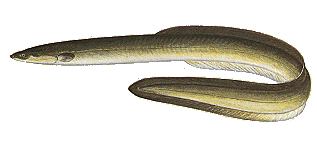Anguilla rostrata

AMERICAN EEL
Anguilla rostrata

Preferred Habitat: Females remain in coastal rivers and reservoirs. Males locate close to tidal areas.
Range: Coastal plains into piedmont streams and reservoirs
Common Size: 2.5 feet and 1/2 to 3 pounds.
Food Habits: Fish, insects, worms, snails, clams, crabs
Spawning: Spawning begins when adults leave fresh water and brackish habitats and migrate to an area in the Atlantic Ocean east of the Bahamas and southwest of Bermuda in a region referred to as the Sargasso Sea. The larger females which live further upstream in rivers and reservoirs will begin migration out of fresh water once they are sexually mature, usually about five to seven years. As the females enter the coastal zones of the river, they are joined by the males, which as a rule do not venture far inland. Very little is known about the eels’ behavior after they leave fresh water, but it is known that a single gathering of the reproducing adults does occur in the deep water of the Sargasso Sea. The newly hatched eels transform through several life stages as they are carried by ocean currents, back to freshwater rivers. This period from spawning to reentry takes about one year. The female elvers migrate upstream to grow and mature while the males remain in the coastal area.
Miscellaneous: The elongated snakelike body of the American eel is often confused from their look-alike, the lamphreys. Their body skeletal structure of bone and a true mouth with functional jaws distinguish them from their look-alikes, the parasitic lamphreys. The entire body is covered with embedded scales that are so minute the fish appears scale less. Eels are a highly esteemed food fish particularly in Europe and Japan where they re served smoked, pickled and fried. Anglers can catch eels but they are generally sought by trapping. It is a myth that eels are male catfish.